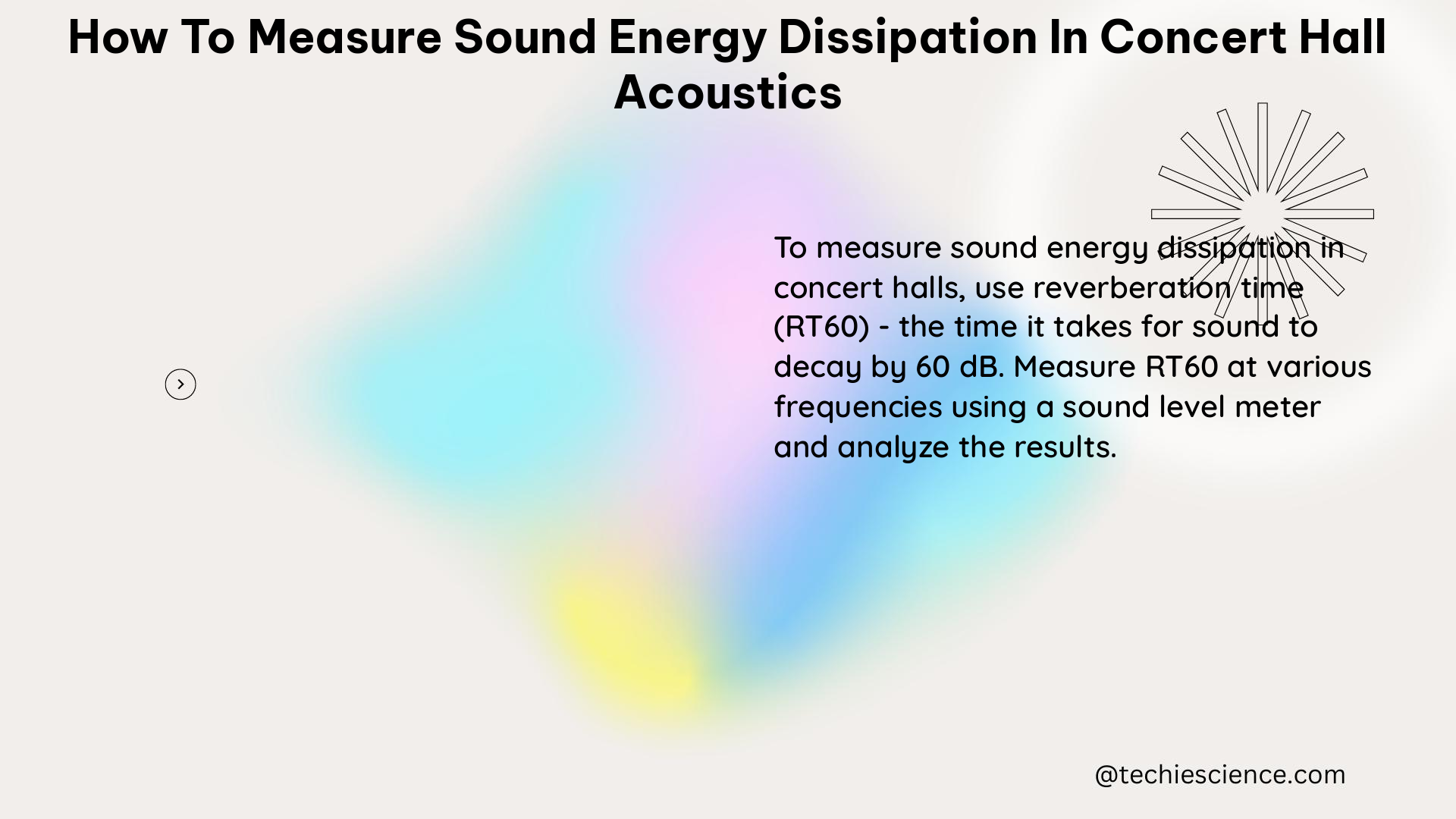Measuring sound energy dissipation in concert hall acoustics is a crucial aspect of ensuring optimal acoustic performance. This comprehensive guide will delve into the technical details and provide a step-by-step approach to accurately quantifying the decay of sound energy over time in performance spaces.
Understanding Reverberation Time (RT)
The primary parameter used to measure sound energy dissipation is reverberation time (RT), which is the time it takes for sound energy to decay by 60 decibels (dB) in a given space. Reverberation time is a function of frequency and is typically measured in octave bands from 125 Hz to 4 kHz.
The formula for calculating reverberation time is:
RT = 0.161 * V / A
Where:
– RT is the reverberation time in seconds
– V is the volume of the room in cubic meters
– A is the total sound absorption in the room in square meters
To measure reverberation time, acousticians use specialized equipment such as omnidirectional sound sources and microphones, along with impulse response measurements and sophisticated software for data analysis.
Measuring Other Room Acoustic Parameters

In addition to reverberation time, there are several other measurable room acoustic parameters that provide insights into sound energy dissipation:
- Sound Strength (G): Measures the amplification of the room to a sound, expressed in decibels (dB).
- Early Sound: Includes the initial-time-delay gap (ITDG), which measures the time at which the first reflection is heard after the direct sound.
- Apparent Source Width (ASW): Measures the width of the sound source as heard by the listener.
- Listener Envelopment (LEV): Measures the degree to which the listener is enveloped in sound.
- Stage Factors: Measure the acoustical conditions on stage for musicians.
These parameters are typically measured using the same equipment and techniques as reverberation time, following the guidelines provided in the ISO 3382-1 standard.
Architectural Design and Acoustic Treatment
The sound energy dissipation in a concert hall is managed through a combination of architectural design and acoustic treatment. In the case of the EMPAC Concert Hall, the following design choices were implemented:
- Large-scale Convexity: The large-scale convexity of the room reduces the need for applied acoustic treatment.
- Upstage Wall Treatment: The only large-scale concave surface in the room, the lower portion of the upstage wall, is horizontally striped in layers of undulating maple spaced by dark reveals of wenge to counter the focusing effect of the shape.
- Sidewall Treatment: The sidewalls are left as dead-flat maple strips with shallow wenge reveals of a quarter inch in depth, resulting in strong and true sound reflections that are altered neither in frequency content nor wavefront shape.
- Ceiling and Lid: The fabric ceiling and the massive concrete lid maintain a full spectrum of sound energy, with the balance between these two architectural elements being frequency-dependent, resulting in an effective variable volume while the physical dimensions of the hall remain static.
- Suspended Reflectors: The EMPAC Concert Hall features suspended reflectors off the ceiling, at angles that reflect sound towards different audience sections, and reflectors on stage to support musicians.
Measuring the Effectiveness of Design Choices
To measure the effectiveness of the architectural design and acoustic treatment in the EMPAC Concert Hall, acousticians would need to take measurements of the room acoustic parameters in various locations throughout the hall. These measurements would include:
- Reverberation Time (RT): Measured in octave bands from 125 Hz to 4 kHz to assess the decay of sound energy over time.
- Sound Strength (G): Measured to evaluate the amplification of the room to a sound.
- Early Sound Parameters (ITDG): Measured to determine the time at which the first reflection is heard after the direct sound.
- Apparent Source Width (ASW): Measured to assess the perceived width of the sound source.
- Listener Envelopment (LEV): Measured to evaluate the degree of sound envelopment experienced by the listener.
- Stage Factors: Measured to assess the acoustical conditions on stage for musicians.
These measurements would be compared to target values and just noticeable differences (JNDs) to determine the effectiveness of the design choices in managing sound energy dissipation. The data collected would provide quantifiable insights into the acoustic performance of the concert hall.
Conclusion
Measuring sound energy dissipation in concert hall acoustics is a complex and multifaceted process that requires a deep understanding of room acoustics and the use of specialized equipment and techniques. By following the guidelines outlined in this guide, acousticians can accurately quantify the decay of sound energy over time and evaluate the effectiveness of architectural design and acoustic treatment in managing sound energy dissipation. This knowledge is crucial for creating optimal acoustic environments in performance spaces.
References
- The Sound of EMPAC. (n.d.). Retrieved from https://empac.rpi.edu/program/research/sound-empac
- Concert Hall Acoustics. (n.d.). Retrieved from https://odeon.dk/learn/articles/concert-hall-acoustics/
- Heyser, R. C., & Beranek, L. L. (2004). Aspects of Concert Hall Acoustics. Retrieved from https://www.aes.org/technical/heyser/downloads/AES123heyser-Beranek.pdf
- An Assessment of the Importance of the Early-To-Reverberant Sound-Energy Ratio in Concert Hall Acoustics. (2016). Retrieved from https://proaudioencyclopedia.com/an-assessment-of-the-importance-of-the-early-to-reverberant-sound-energy-ratio-in-concert-hall-acoustics/
- Lokki, T. (2016). Why is it so hard to design a concert hall with excellent acoustics? Retrieved from https://acoustics.asn.au/conference_proceedings/AASNZ2016/papers/p43.pdf

The lambdageeks.com Core SME Team is a group of experienced subject matter experts from diverse scientific and technical fields including Physics, Chemistry, Technology,Electronics & Electrical Engineering, Automotive, Mechanical Engineering. Our team collaborates to create high-quality, well-researched articles on a wide range of science and technology topics for the lambdageeks.com website.
All Our Senior SME are having more than 7 Years of experience in the respective fields . They are either Working Industry Professionals or assocaited With different Universities. Refer Our Authors Page to get to know About our Core SMEs.